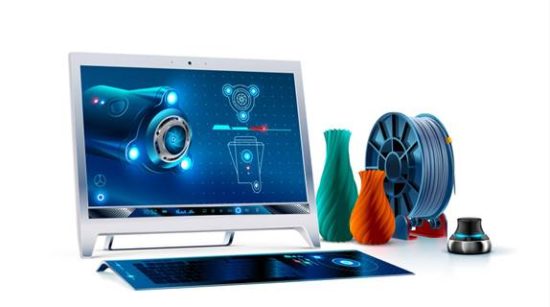by Bob Cramblitt

Earlier this year, an article in Graphic Speak dealt with widespread misconceptions about the differences between professional workstations and gaming PCs.
Given the diversity of applications employed and operations performed on professional workstations, it’s only natural that users would have different assumptions about performance. Some of these assumptions are likely to be accurate, and some not so. In an effort to find out which is which, we enlisted a group of workstation performance experts to discuss common misconceptions about workstation performance.
One result doesn’t fit all
 Alex Herrera, senior analyst at Jon Peddie Research, touched on the “good for one, good for all” perception when it comes to evaluating workstations.
Alex Herrera, senior analyst at Jon Peddie Research, touched on the “good for one, good for all” perception when it comes to evaluating workstations.
“Some assume that if a machine is configured to be high performance for one application, it automatically means it will be high performance running professional workstation applications.”
“A common example is assuming a high-end gaming PC should perform as well on CAD or digital content creation as it does on gaming. Both workstation hardware and software (like graphics drivers, for example) are shaped differently to provide the best performance specifically for workstation applications, without compromising on reliability.”
Bottlenecks will vary
 Chris Angelini, editor emeritus at Tom’s Hardware, also pointed out a lack of recognition among users about performance anomalies across different applications.
Chris Angelini, editor emeritus at Tom’s Hardware, also pointed out a lack of recognition among users about performance anomalies across different applications.
“A mischaracterization of bottlenecks is what I see most often among users. Workstation applications tend to be specialized, taxing specific subsystems in dissimilar ways. Knowing what hardware your application of focus needs for optimal performance is key before making purchasing decisions. For example, an application’s most sensitive routines may be graphics-bound, but the system only supports acceleration via CUDA or OpenCL.”
Hitting the right balance
 Oliver Baltuch, a computer technology consultant and former president of Futuremark, thinks workstation purchasers often place too much emphasis on graphics performance.
Oliver Baltuch, a computer technology consultant and former president of Futuremark, thinks workstation purchasers often place too much emphasis on graphics performance.
“I think the most basic miss by purchasers is to consider graphics performance only when they make a purchase. The most important feature of a workstation should be the right balance between CPU, GPU, memory, and storage. Similar to how a car is built getting the balance between engine, brakes, and suspension (steering). Too much of one leads to a bottleneck in other areas. If the balance is built-in from the beginning, the experience, even for someone very concerned about graphics performance, will be better.”
Bigger not always better
 Jon Konieczny, vice chair of the SPEC Graphics Performance Characterization (SPECgpc) subcommittee, thinks that sometimes too much weight is placed on big benchmark scores without determining the proper fit for the user’s application.
Jon Konieczny, vice chair of the SPEC Graphics Performance Characterization (SPECgpc) subcommittee, thinks that sometimes too much weight is placed on big benchmark scores without determining the proper fit for the user’s application.
“A big misconception is that a higher score is always better. Getting a giant score on a particular benchmark may not mean you’re actually getting a better experience. At some point, your application performance fits your need for the task at hand and you don’t need anything more.
“Running a benchmark isn’t just about finding what is fastest; it can help a user decide the best graphics card within a certain budget that will provide good interactivity for the user’s particular environment. Running a benchmark that’s similar to your own workload and environment is important in determining the right fit.”
Too much performance?
 Alex Shows, chair of the SPEC Workstation Performance Characterization (SPECwpc) subcommittee, provides an example that supports Konieczny’s points.
Alex Shows, chair of the SPEC Workstation Performance Characterization (SPECwpc) subcommittee, provides an example that supports Konieczny’s points.
“One example in the ‘too much performance’ category is when your graphics card renders so fast that it becomes more important to overall performance and productivity to shift the focus elsewhere, such as a faster storage device, higher frequency CPU, or populating more memory channels.”
But Shows acknowledges that what might be considered “too much performance” now could be just right in the future:
“That additional performance capability helps lengthen the usable life of the workstation and empowers the user with the flexibility to work on higher complexity projects in the future, so it’s still a good investment in the long run.”
What’s your take?
Is there a common workstation performance misconception you see? Please leave a comment below.
Bob Cramblitt is communications director for the Standard Performance Evaluation Corp. (SPEC). He writes frequently about performance issues and digital design, engineering and manufacturing technologies.
To find out more about graphics and workstation benchmarking, visit the SPEC/GWPG website, subscribe to the SPEC/GWPG enewsletter, or join the Graphics and Workstation Benchmarking LinkedIn group: https://www.linkedin.com/groups/8534330.
SPEC/GWPG benchmarks are available for free downloading to everyone except vendors of computers and related products and services that are not members of the SPEC Graphics and Workstation Performance Group (SPEC/GWPG).





